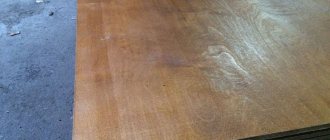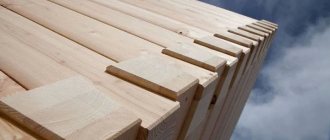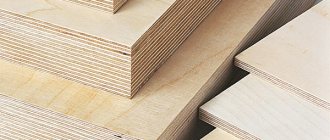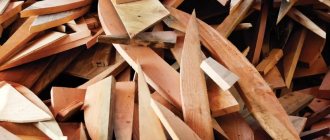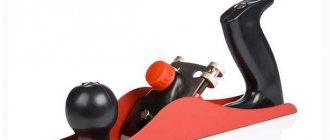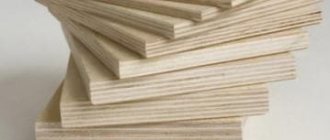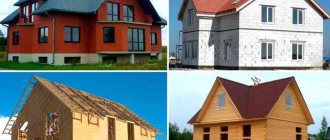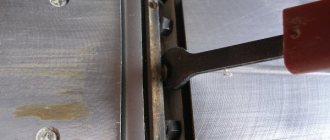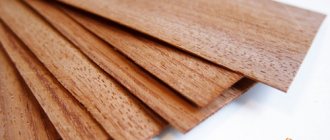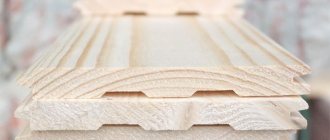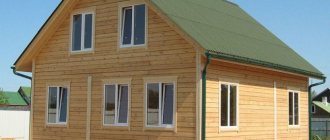In industry and construction, materials are often needed that are equally resistant to adverse environmental factors and mechanical stress, while being lightweight and inexpensive. Almost all types of plywood on the market best meet the listed requirements. This article provides a generally accepted classification, discusses the main technical characteristics and purpose of the material.
First, let's answer the question, what is plywood, how is it made and what does it consist of? This material is a wood-sheet board glued together from specially treated peeled veneer. Each subsequent sheet is laid in such a way that the direction of the fibers in each of the two adjacent layers is perpendicular to each other. This significantly increases the strength characteristics of this material.
What is plywood made of?
Plywood is designed as a wooden raw material with layers, which has at least 3 layers. The layers contain veneer or wood bark.
When creating, the veneer is placed in a separate layer across the last one, therefore the density and strength increases, and the mixture used for gluing the layers increases the resistance to moisture.
Distinctions according to variety
- Grade E – selected species. Flaws are not permissible, except for small changes that accidentally appear in the structure of the tree.
- Grade 1 – the greatest extent of warping or cracks should not be more than 20 mm.
- Grade 2 – crevices up to 200 mm, wooden inserts, glue leakage into the plot up to 2% of the entire sheet square are allowed.
- Grade 3 - up to 10 defects per m2 are allowed, with the diameter of an individual no more than 6 mm. The total number of mentioned defects cannot be more than 9.
- Grade 4 – very low quality. May contain the following defects: sometimes fused and popping knots - without counting. Flaws in the edges of the sheet up to 5 mm.
Based on this, the grade of plywood differs in the presence and number of flaws on the plane of the wooden material.
Other selection factors
The choice of plywood sheets for furniture manufacturing is influenced by the following factors:
- Variety Elite is the best choice. But it cannot be found on the open market, since it is sent in bulk to furniture factories on special orders. But grades 1 and 2 are also good options. To save money, you can choose 1/2 or 1/3 grades. The front side will be the one whose outer layer of veneer is grade 1. The reverse side will be wrong side.
- Thickness. For cabinet furniture, the optimal thickness is 15-18 mm. For podiums – at least 20 mm. For non-load-bearing partitions, thinner sheets can be used - about 8-10 mm. For sealing the back wall of furniture and constructing the bottom of drawers, plywood 3 mm thick is suitable. For this purpose, you can also purchase cheaper fiberboard material.
- Surface treatment method. Plywood must be sanded on both sides. To save money, you can buy unsanded sheets, but in this case you will have to sand them yourself.
When choosing plywood for furniture, also pay attention to its format. It should be enough to cut workpieces of specified sizes. Please note that the standard size of FC sheets is 1525x1525 mm. To prevent the formation of seams in unnecessary places when making large-sized furniture, it is better to purchase laminated plywood, which is produced in the 2500x1250 mm format .
Types of glue for plywood
- FSF - consists of phenol-formaldehyde, has the highest degree of moisture resistance. Since it contains harmful compounds in its contents, it is not recommended for the manufacture of furniture or in residential buildings.
- FKM - contains melamine, has a satisfactory level of resistance to moisture. It has a reduced amount of harmful components, as well as lower moisture resistance, therefore it can be used wherever high requirements for moisture resistance and toxicity parameters are not imposed.
- FC – contains urea, has a low degree of moisture resistance. It does not contain harmful components, therefore it can only be used for the interior design of living rooms, kindergartens, and furniture.
- FBA – consists of albumin and casein. The product is not resistant to moisture. This plywood is environmentally friendly and can be used anywhere where increased resistance to moisture is not required.
Use of plywood in furniture production
Depending on the brand and type, plywood is used for finishing interior rooms, making chairs, tables, chests of drawers and shelves.
Construction plywood is the basis for insulation and leveling of floors, walls and ceilings, formwork. Plywood for furniture is a high-quality type of material with high strength characteristics. Decorative - a smooth and even base containing film or paper.
Plywood is veneered using a hot press.
In order for a table, chair or cabinet to be functional and durable, attention is paid not only to the quality of the material itself, but also to the assembly technique. When assembling a product from several pieces, it is important to know several features: they begin to assemble only when the individual glued pieces have dried well, and excess glue is removed immediately after application.
The drawing also plays an important role in the quality of the product. The difference between a plywood table or a separate part of it from FSF, FC (for example, the table legs are made of plywood, and the table top is made of plastic or glass) is perfect symmetry.
When cutting plywood, take into account the power of the jigsaw. It is also worth taking into account the need for gaps for grinding sharp corners.
Processing plywood for furniture production requires the presence and observance of a number of rules:
- Grinding is done carefully so that there are no uneven surfaces and the surface of the product does not have a hitch.
- In addition to high-quality processing, strong adhesion of the parts to each other is carried out.
- Drilling holes for self-tapping screws is made in a smaller capacity than the self-tapping screw itself. This is necessary for strong maximum adhesion of the parts.
- Use wood glue for additional fixation.
- It is important to ensure an even joint between the parts.
- The material is treated with sealant and chipboard primer.
The primer for treatment should contain water, not oil.
Types of plywood by plane
Differences between plywood based on the created top ball:
- Laminated - to strengthen all the properties of wood, the outer layers are covered with a special film for additional protection of the plane;
- Sanded on both sides (W 2);
- Sanded one side (W 1);
- Not polished (NS).
The plane of the plywood can be sanded in order to neutralize flaws and provide it with a more beautiful appearance.
Often laminated and sanded are used for final or aesthetic finishing, as well as for the formation of visible furniture elements.
Rules for installing plywood sheets
To sheathe walls with plywood, both frame and frameless structures can be used.
Frameless is used when finishing walls in an apartment or other room with flat walls - this method is simple, installation is quick: the slabs can be glued to a flat wall surface, it is recommended to glue the joints together. This method is good because it allows you to mount the finishing surface without additional modifications.
Finish wall cladding
A frame structure will require more time, but this is necessary for uneven walls, as well as when laying insulation or sound insulation is required. For the frame, wooden blocks or galvanized plasterboard profiles are used.
Decorating the walls in an apartment begins with electrical installation work; cables and wires are supplied to distribution boxes, panels, sockets, etc.
Types of plywood by wood type
According to the type of wood veneer, there are 3 types: coniferous, birch and composite type. To do this, only the contents of the outer layers are examined.
Let's take a closer look:
- Coniferous species. The layers of this plywood are made from the bark of coniferous trees. In the Russian Federation, they are mostly made from spruce and pine. It is not as strong as birch, but its weight is 20% less, and its contents contain natural resins that protect it from damage and decay. It also has a beautiful plane ornament and its cost is less than that of hardwood. Due to the fact that its main advantages are in weight, cost and aesthetic surface - raw materials are often purchased for private construction, the following are created: partitions, roofs, decking, various outdoor and indoor decoration, also for decorative products, as well as in design;
- Made from birch - classified as a deciduous type of plywood required for construction. Birch bark veneer is a very strong and compacted material with a uniform structure. The density of the described plywood is 650 kg/m3 - this indicates that a sheet made from such raw materials has 20% greater strength than those made from other types of wood. It does not contain natural resins and is more expensive than others;
- Composite - layers of compatible plywood accommodate different types of hardwood and coniferous wood. In terms of quality parameters, it is close to the birch product, but its cost is cheaper. It is used in construction work, furniture making, packaging and other areas.
Blocks
There are many different types of blocks. The most common foam blocks and gas blocks. Gas blocks and foam blocks have gained great popularity in the construction of private houses in a short time. They have a number of advantages, good heat resistance, sound insulation, lightweight in size compared to other materials, due to this, lower costs for the foundation. Disadvantages: quite fragile, they need to be lined as they quickly absorb moisture due to their porous structure. The cost of a house made of foam blocks will be 11,000 - 20,000 rubles. m2.
Types of plywood by purpose
Plywood rectangles are useful not only for building houses and decorating rooms.
It is used much more widely:
- Furniture type. It is wear-resistant and is also considered environmentally safe. Basically it is a composite product of FA, suitable for being in conditions of average moisture levels;
- Construction view. Sheets made from birch are perfect for any type of rough sheathing;
- Formwork type. Plywood marked FB, due to its high strength and moisture resistance parameters, will be able to remain in an environment of negative, natural influences;
- Decorative variety. This plywood is designed for finishing interior cladding, often using high-quality veneer. Here you can see the very aligned, outer planes of the sheets; relief marks are visible on them;
- Ship's view. For the construction of ships, moisture-resistant FB sheets are often used; bakelite glue is used to produce them;
- Automotive type. FSF plywood is used to trim truck bodies. Plates are taken with lamination, and sometimes with a mesh-ribbed outer plane.
Frame assembly
To install the frame you will need plywood, wooden beams (galvanized profile), direct hangers, fasteners: screws, dowels. Also some tools: a hammer, a screwdriver, a jigsaw (circular saw), a tape measure, a building level and a corner.
- At the first stage, the walls are marked. Using a building level, mark vertical guides in increments of about 60-80cm - the increment depends on the size of the sheet, which must be connected horizontally to at least three points, one must be strictly in the middle. Horizontal markings are also made under the ceiling and near the floor.
- Screw vertical plumbs onto the wall in increments of 50-70cm, onto which the frame elements will be attached.
- The frame begins to be assembled with horizontal guides, after which they move on to installing vertical ones. The distance between the wall and the front side of the profile is set taking into account the goals (presence of noise and heat insulation).
Vertical posts are placed along the edges of the wall and twine is pulled between them. With its help, all other guides are set. This simple technique will help you avoid unevenness.
- After the frame is ready, it is treated with an antiseptic composition, after which it is ready for hanging sheets.
Frame for a rough plywood base
Plywood sheet sizes
The standardized width of plywood sheets is 1220 and 1525 mm.
- The maximum mini length is 1525 mm, and the longest reaches 2500 mm.
- Nowadays, manufacturers often offer rectangular-shaped slabs with dimensions of 2440×1220 mm, and also square-shaped slabs with dimensions of 1525×1525 mm.
- With the exception of large format products, the length for them can be 3050 mm. The thickening of plywood is determined by the number of layers.
According to GOST standards, there are prescribed parameters - from 3 - 30 mm.
There are also standards in force that enable individual, special companies to produce slabs with a thickness of over 1 mm.
How it is made
Plywood is often used in furniture production. Typically, sheets with a thickness of 3 to 30 mm are used. The advantage of plywood over natural wood is that it is cheaper and has the same dimensions.
Production begins with the production of thin layers of wood, so-called veneers, which are subsequently glued together. Their number is always odd and starts from three.
The best plywood is made from birch. This is a strong and durable natural material. It can be made entirely from one breed, or from several. With equal thickness, it is approximately 20% stronger than coniferous wood and does not release natural resins in hot weather. Its cost is higher than that of coniferous samples.
To increase strength and add moisture resistance, the plywood sheet goes through a lamination process. The presence of such a film makes it easy to clean. In addition, this is a big plus from a design point of view. The film can be of different colors and textures: walnut, beech, oak or even mahogany.
Which brand is best to use?
When creating furniture, moisture resistance does not play an important role. In most products it is only 6-11%. Safety, environmental friendliness and aesthetic appearance are more important.
FSF brand plywood is least suitable for this category, as it contains a high level of toxic phenol-formaldehyde resins. They take a very long time to erode, and using them indoors is generally hazardous to health.
Another option is the FC brand. Its strength indicators are higher, it is non-toxic due to the use of urea glue. Can withstand heavy loads, is easy to process and easy to sand. Therefore, it is recommended to use this type to create furniture.
Photos of all types of plywood
C 2 4
What does grade 2 4 mean? If we consider grade 2 4, then such a product is characterized by flaws on the front side, which are typical for grade 2. On the back side of the plywood there are defects characteristic of a grade 4 product. Unlike 4 4 plywood, this material has a better appearance, so it can be used for interior decoration. Another difference between them is the cost; the first option has a higher price.
What is plywood grade 2 4 can be found out in this article.
Price
The price of this material is not too high, which is why it is in great demand among consumers. The average price for 4 4 plywood is 560 – 690 rubles per sheet.
To find out what is better to mount plywood or OSB on walls, you need to read this article.
Plywood 4 4 is not the highest quality material, since there are a large number of flaws on its surface. But this does not prevent such a product from being used in various fields of construction. Such plywood, despite its unattractive appearance, has high strength indicators, which is why it is used in the construction of structures for which the important criterion is not beauty, but reliability.
Production Features
The basis of production is the production of veneer from birch pieces. The technological process uses:
- Deciduous trees. In most cases, birch is used.
- Coniferous trees. In this case, pine comes first; cedar is also used.
At the factory, this layered material is produced in several types. He can be:
- Homogeneous. Only one type of wood is taken.
- Combined. To make it, several types of trees are used.
Plywood production.
The outer layers are always made only from special, high-quality veneer. The front layers are necessarily made of wood. All other layers can be made from veneer that has not passed quality testing.
To glue plywood sheets together, adhesives containing additional formaldehyde resins are used. The final stage of manufacturing plywood sheets is considered to be mechanical processing of the front surface.
The quality of the outer surface of the material can be very different. Therefore, plywood, depending on this indicator, is divided into several types:
- unpolished;
- polished;
- primed;
- plywood with a coating made from a variety of materials (film, textured paper, decorative veneer are used).
The number of layers of plywood is not the same, sometimes the number exceeds 23. To improve the uniformity of the material and to eliminate deformation that occurs during shrinkage of fibers in adjacent layers, the material is produced in three types:
- diagonal;
- star-shaped;
- unidirectional.
There are also divisions and plywood structures. It is divided into several types:
- Longitudinal. In this case, the long side should be parallel to the grain.
- Transverse. In this case, the long side should be perpendicular to the fibers.
The appearance of plywood is divided into several grades:
Appearance of different varieties.
- I, Ix - this type of material is of high quality. There are no serious external defects. The presence of small knots with a diameter of less than 15 mm is allowed. No more than five pieces are allowed per square meter. If the diameter of the knots is less than 6 mm, three knots are allowed per square meter.
- II, IIx – this material is of good quality. It may have veneer inserts. The presence of 10 knots is allowed, with a diameter not exceeding 25 mm, per square meter. The presence of unfused knots should not exceed 6 per 1 square meter.
- III, IIIx - this type is considered average in quality. It may have characteristic visible defects. In one square meter, the presence of 10 different falling knots with a diameter of less than 6 mm is allowed.
- IV, IVx – these sheets are of the lowest grade. They are produced with a variety of external defects.
Technological properties
The properties of the material and its main characteristics depend on the adhesive composition. The level of moisture resistance of the glue affects the appearance of the sheets. The material is divided into several types:
Selection of veneer for plywood grades.
- FC. The basis is urea glue, which contains additives from formaldehyde resins. This plywood is considered waterproof.
- FSF. For production, phenol-formaldehyde glue is used. As a result, the material becomes moisture resistant and belongs to a high class;
- FBA. This material is non-moisture resistant. To make such sheets, casein glue is used.
Sheets containing free formaldehyde are divided according to the type of existing emission:
- E1. The material contains 10 mg for every 100 g of weight of standard moisture.
- E2. The presence of formaldehyde is allowed for every 100 g of weight, but not more than 30 mg.

